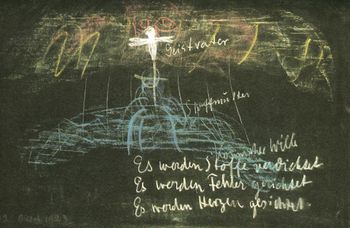Historical conscience

The historical conscience is mentioned by Rudolf Steiner in a lecture on St. John's Imagination.
At the time of St. John's Day, the spiritual-soul of the Earth - in the hemisphere where it is summer - is at its most exhaled. In the heights of the Earth, the cosmic intelligence is reflected in the image of Uriel (Michael has a somewhat different task as the administrator of cosmic intelligence). Below, in the dark blue of the earth's depths, the material mother, the Earth Mother, appears. As shining silver threads and lines, the crystal-forming forces become visible in this bluish depth and show themselves in their strict, but vividly designed geometrical order. This strict order, however, is only an ideal image. In fact, errors, aberrations and distortions appear in this depth in this order, which have arisen through the errors and transgressions of humanity - an image of the karma of humanity, which people have burdened themselves with in the course of their development. With a serious gesture Uriel points to this image and thus wants to awaken in us what Rudolf Steiner called the "historical conscience".
„And Uriel's serious gaze is directed towards this contrast of the crystallisation of nature in its regular beauty and the human error weaving itself over it. Here, at the height of summer, is seen through what is still imperfect in the human race in comparison with the regularly building crystal formations. It is here that one receives the impression, I would say, from Uriel's serious gaze: the natural is interwoven with the moral. The moral order of the world does not merely stand in us like abstract impulses, but we now see, while we otherwise look at the existence of nature and do not ask: Does morality live in the growth of plants? Does morality live in crystallisation? - how human errors and regular, consistent, consolidated crystallisation of nature also weave together naturally in the midsummer season. On the other hand, everything that is human virtue, that is human efficiency, goes upwards with the shining silver lines and appears like the enveloping clouds of Uriel (red), enters, so to speak, as human virtue transformed into works of art, into cloud-sculpture, into the shining intelligence. One cannot merely look at the serious face-eye of Uriel, which becomes serious through the view of the earth's depths, but one can also look at something which, I would like to say, like wing-like arms or arm-like wings, is there in serious admonition, and which works precisely as a gesture of Uriel, which leads into the human race that which I would like to call the historical conscience. Here in the midsummer period appears the historical conscience, which is extraordinarily weakly developed, especially in the present. It appears as in the admonishing gesture of Uriel.“ (Lit.:GA 229, p. 69)
Literature
- Rudolf Steiner: Das Miterleben des Jahreslaufes in vier kosmischen Imaginationen, GA 229 (1984), ISBN 3-7274-2290-4, Vierter Vortrag, Dornach, 10. Oktober 1923 English: rsarchive.org German: pdf pdf(2) html mobi epub archive.org
 |
References to the work of Rudolf Steiner follow Rudolf Steiner's Collected Works (CW or GA), Rudolf Steiner Verlag, Dornach/Switzerland, unless otherwise stated.
Email: verlag@steinerverlag.com URL: www.steinerverlag.com. Index to the Complete Works of Rudolf Steiner - Aelzina Books A complete list by Volume Number and a full list of known English translations you may also find at Rudolf Steiner's Collected Works Rudolf Steiner Archive - The largest online collection of Rudolf Steiner's books, lectures and articles in English. Rudolf Steiner Audio - Recorded and Read by Dale Brunsvold steinerbooks.org - Anthroposophic Press Inc. (USA) Rudolf Steiner Handbook - Christian Karl's proven standard work for orientation in Rudolf Steiner's Collected Works for free download as PDF. |
